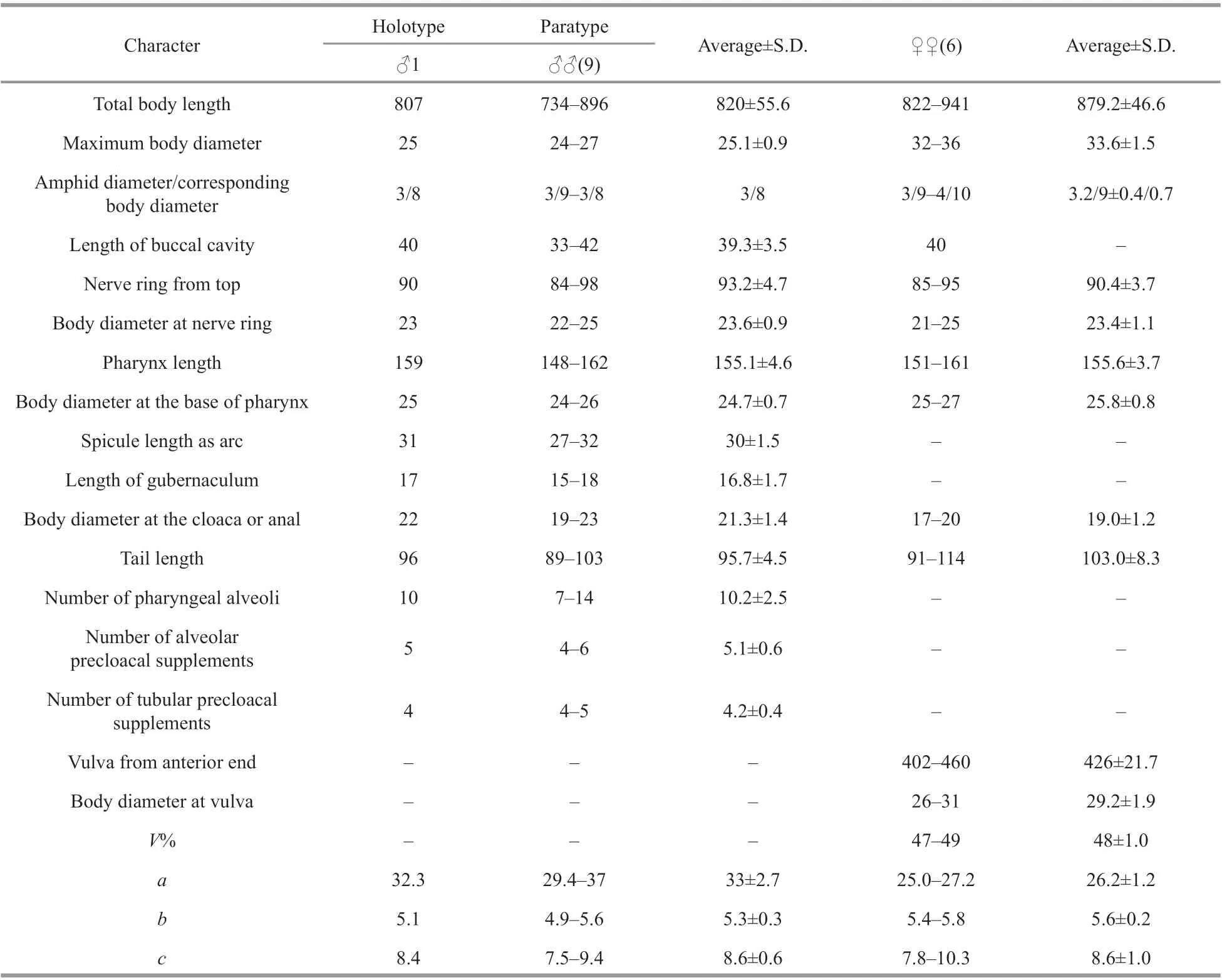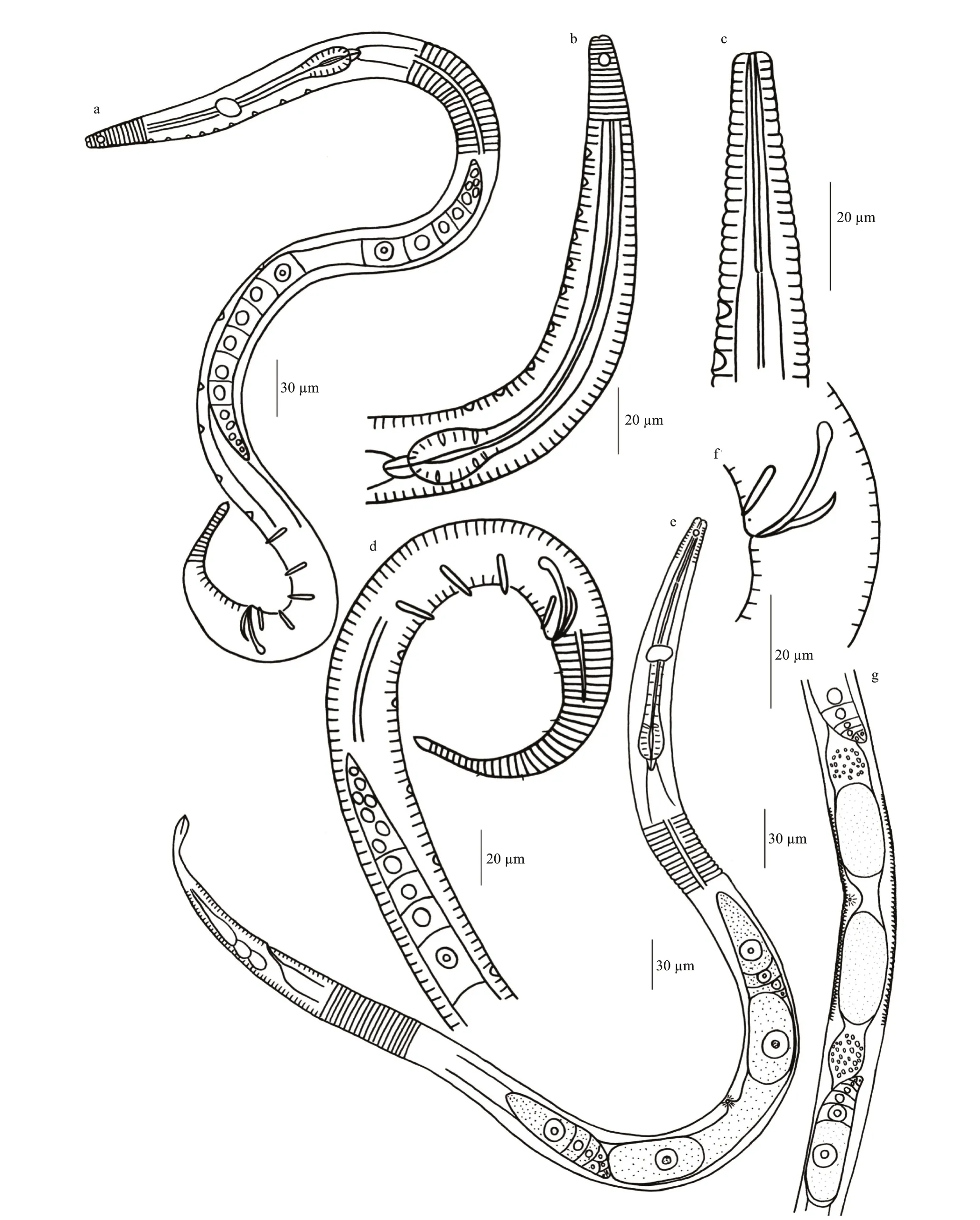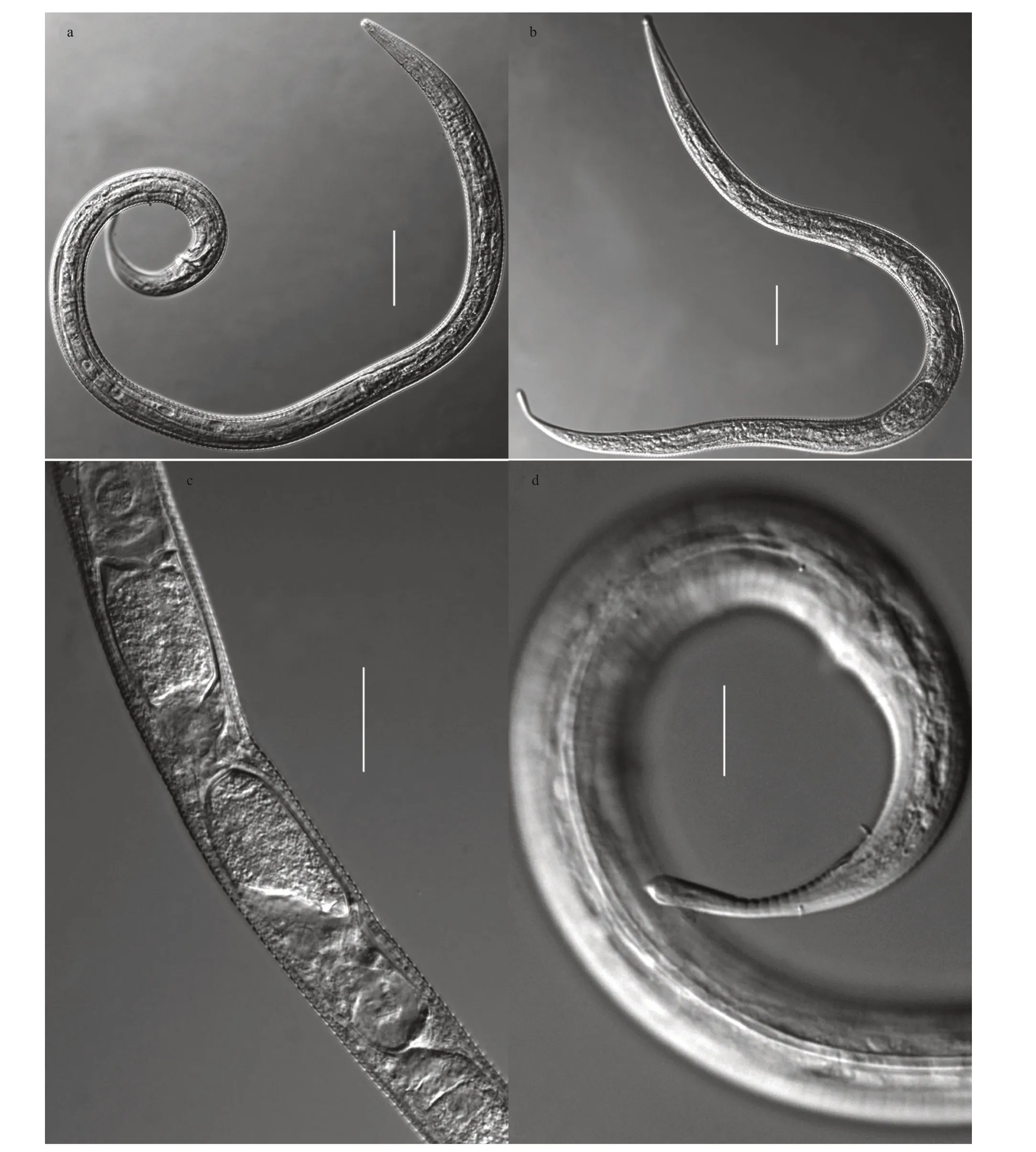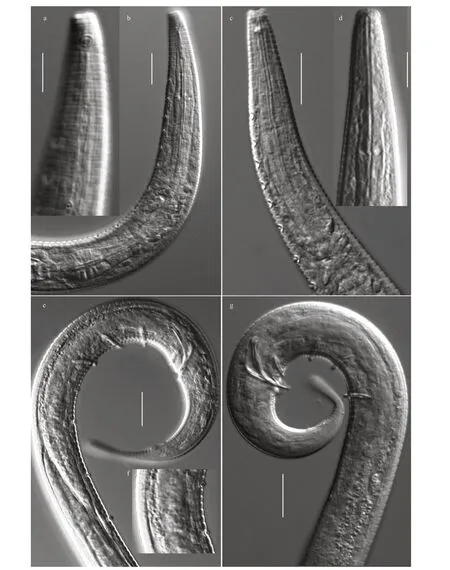Leptolaimus holovachovi sp. nov. (Nematoda) from Shenzhen Mangrove Nature Reserve, Shenzhen, South China*
QIAO Chunyan , JIA Susu , HUANG Yong , ,
1 College of Life Sciences, Liaocheng University, Liaocheng 252059, China
2 Key Laboratory for Ecological Conservation and Biodiversity of Institution of Higher Learning of Shandong Province, Liaocheng 252059, China
Abstract A new free-living marine nematode species of the genus Leptolaimus belonging to the family Leptolaimidae was collected from intertidal sediments of the Shenzhen Mangrove Nature Reserve, Shenzhen, South China, and it is described here as Leptolaimus holovachovi sp. nov. The new species is characterized by body length 734–896 μm in males and 822–941 μm in females; papilliform cephalic sensilla; circular amphideal fovea; males with 7–14 anterior midventral alveoli in the pharyngeal region, 4–5 midventral tubular precloacal supplements and 4–6 alveolar precloacal supplements; spicules slender, slightly arcuate, proximally cephalated and distally pointed. Plate-like gubernaculum without apophyses. The new species diff ers from other congener species of the genus by the unique feature of having anterior midventral alveoli in the pharyngeal region.
Keyword: new species; free-living marine nematode; taxonomy; South China Sea
1 INTRODUCTION
The genusLeptolaimusde Man 1876 is a common genus from intertidal to sublittoral regions. At present, a total of 58 valid species have been recorded in the world (Bezerra et al., 2019).Leptolaimusis characterized by annulated cuticle, presence of lateral alae, papilliform or setiform cephalic sensilla, ventrally unispiral (circular in outline) amphideal fovea, elongated tubular buccal cavity, and male reproductive system diorchic, may have both tubular and alveolar precloacal supplements, one or no supplement at all. The number of supplements varies from zero to 40 for alveolar and zero to 11 for tubular; tubular supplements not present in cervical region, and may also be present in female. The female has two opposed and refl exed ovaries (Holovachov, 2014). In 2013, Holovachov and Boström have revised the genusLeptolaimus. They listed 58 valid species and eight species inquirendae, fi ve species were transferred to other genera (Holovachov and Boström, 2013). Soon afterwards, Tchesunov (2015) described a new species of the genus. Recently,LeptolaimustchesunoviTsalolikhin, 1979 was accepted asLeptolaimuslongispiculusAlekseev & Rassadnikova, 1977 (Bezerra et al., 2019). Of 58 valid species ofLeptolaimus, 13 species possess both alveolar and tubular precloacal supplements, 41 species—only tubular precloacal supplements, three species—only alveolar precloacal supplements and one species—no supplementary organs at all. All these recorded species have no anterior midventral alveoli in the pharyngeal region.
Up to now, more than 200 nematode species have been identifi ed with the aim to study the biodiversity of free-living marine nematodes from the South China Sea (Jia and Huang, 2019; Zhai et al., 2019). Shenzhen mangrove nature reserve is located in Futian mangrove area of north east coast of the Shenzhen Bay. The abundance and diversity of marine nematodes in mangrove nature reserve are quite abundant. In this study, the nematode abundance is 1 871 ind./10 cm2, andDaptonema,Parodontophora, andSteineriaare the widespread distribution and dominant genera. In this region, an unrecorded species belonging to genusLeptolaimuswas discovered and is described here asLeptolaimusholovachovisp. nov.
2 MATERIAL AND METHOD
In January 2019, the meiofauna samples were collected using a sawn-off syringe with a 2.6-cm inner diameter from intertidal zone of Futian mangrove in Shenzhen mangrove nature reserve along the north east coast of the Shenzhen Bay (22°31′21″N, 113°59′15″E). The samples were taken to a depth of 8 cm and divided into three sections, 0–2, 2–5 and 5–8 cm, then fi xed with equivalent 10% formalin in seawater for long-term preservation. In the laboratory, samples were stained with 0.1% rose Bengal for 24 h. The stained samples were washed with tap water to remove residual formalin and then sieved over two mesh sizes (500 and 42 μm) to separate macrofauna (500 μm) from meiofauna (42 μm). Heavier sediment particles were removed using centrifugation in LudoxTM(50% colloidal silica, suspension in water; product of Sigma Aldrich Co., USA) with a specifi c gravity of 1.15 g/mL (de Jonge and Bouwman, 1977). Each sample was washed into a Petri dish respectively with distilled water and meiofauna was sorted under a stereoscopic microscope. Nematodes were transferred into a cavity block containing a solution of 5% glycerol, 5% pure ethanol, 90% freshwater by volume (McIntyre and Warwick, 1984). After ethanol was slowly evaporated, the specimens were mounted in glycerin on permanent slides. The descriptions were made from glycerin mounts using a diff erential interference contrast microscope (Leica DM 2500). Line drawings were made with the aid of a camera lucida. All measurements were made using Leica LAS X version 3.3.3, and all curved structures were measured along the arc. Type specimens were deposited in the Marine Biological Museum of Chinese Academy of Sciences, Qingdao.
3 SYSTEMATICS
Order Plectida Gadea, 1973
Family Leptolaimidae Örley 1880
GenusLeptolaimusde Man 1876
Leptolaimusholovachovisp. nov. (Figs.1–3)
3.1 Type material
Total of 32 specimens were obtained. Of them, ten males and six females were measured. Holotype male on slide SZFT19-37-2. Paratypes on SZFT19-71-8, SZFT19-71-9, SZFT19-31-8, and SZFT19-37-2.
3.2 Type locality and habitat
All the specimens were found from the layers of 2–5 cm and 5–8 cm muddy sediments, intertidal zone of Futian mangrove along the north east coast of the Shenzhen Bay (22°31′21″N, 113°59′15″E). Black mud with a little sand.
3.3 Etymology
The species is named in honor of Dr. Oleksandr Holovachov, Swedish Museum of Natural History, for his contributions to nematodes taxonomy.
3.4 Measurement
All measurement data are given in Table 1.
3.5 Description
Males. Body elongate spindle-shaped. Cuticle annulated. Annuli 2–3-μm wide throughout the body. Lateral alae present, 2-μm wide at mid-body, originating in the middle of the pharynx and extending along the body to the anterior third of the tail. Prominent body pores in sublateral position at both sides of lateral fi eld present. Anteriormost body pore located at level of buccal cavity base. Neither inner, nor outer labial sensilla observed. Cephalic sensilla papilliform. Amphideal fovea circular, 30%–40% of corresponding body diameter, situated at a distance of 5–7 μm from the cephalic apex. 7–14 anterior midventral alveoli in the pharyngeal region. The distance between each other increasing gradually towards the posterior. The most anterioer alveole 33–38 μm from the head end, the last one 92–153 μm from the head end. Narrow elongated tubular buccal cavity prolongated over a long distance into the anterior part of the pharynx, accounting for about 25% of the pharyngeal length. Pharynx slender, posterior region infl ated forming a pear-shaped bulb, with modifi ed internal cuticle, 21–23-μm long and 13–15 μm wide. Cardia elongated conical, about 10-μm long. Excretory system not seen. Tail conicocylindrical, 4.3–4.7 cloacal body diameter, anterior conical portions gradually transforming to posterior slender cylindrical portions, terminal enlarged. Subventral precloacal and caudal sensilla present: two (one pair) precloacal papillae at the middle between cloaca and the fi rst precloacal supplement, and some short caudal setae, usually eight (four pairs)arranged in two subventral and two subdorsal pairs present. Three caudal glands present. Terminal spinneret tubular.

Table 1 Individual measurements of Leptolaimus holovachovi sp. nov. (in μm except a, b, c, number, and V%)
Reproductive system with two outstretched gonads, anterior testis situated to the right of the intestine; posterior testis situated to the left of the intestine. Spicules slender, slightly arcuate, proximally cephalated and distally pointed. Gubernaculum platelike, curved to spicules, without apophyses. Four to fi ve similar midventral tubular precloacal supplements plus 4–6 alveolar supplements, more or less evenly spaced. Tips of tubular precloacal supplements tapered. The most posterior (fi rst) tubular precloacal supplements 6–13 μm from cloaca. The most anterioer alveolar precloacal supplements 184–367 μm from cloaca. The distance of the most posterior tubular precloacal supplements from the most anterioer alveolar precloacal supplements extending 175–357 μm.
Females. Similar to males in most aspects except slightly thicker body without anterior midventral alveolar supplements in the pharyngeal region. Reproductive system didelphic, with two opposed refl exed ovaries; anterior ovary situated to the right, posterior to the left of the intestine. Mature eggs large, oval-shaped. Uterus a wide tube. In some of the females, two saclike spermathecae located on each (anterior and posterior) side of vulva. In other females, spermathecae not observed. Vagina straight, 0.25 times vulval body diameters long. Vulva situated at right-subventral side of mid-body. However, vulva diffi cult to be observed in most of the individuals.
3.6 Diagnosis and discussion

Fig.1 Leptolaimus holovachovi sp. nov.

Fig.2 Leptolaimus holovachovi sp. nov.
Leptolaimusholovachovisp. nov. is characterized by cephalic sensilla papilliform; amphideal fovea circular; males with 7–14 anterior midventral alveoli in the pharyngeal region and 4–5 midventral tubular precloacal supplements plus 4–6 alveolar precloacal supplements; spicules slender, slightly arcuate, proximally cephalated and distally pointed. Gubernaculum plate-like without apophyses.

Fig.3 Leptolaimus holovachovi sp. nov.
Leptolaimusholovachovisp. nov. belongs to a group of species which males have both tubular and alveolar precloacal supplements. Nevertheless, it is the only species possessing anterior midventral alveolar supplements in the pharyngeal region. The unique feature of the pharyngeal alveolar supplements distinguishedLeptolaimusholovachovisp. nov. from all previous known species of the genus. The new species is similar toL.mixtusLorenzen, 1972,L.papilligerde Man, 1876 andL.pumilusGagarin & Thanh, 2009 in small body size and type of precloacal supplements.Leptolaimusholovachovisp. nov. diff ers fromL.mixtusLorenzen, 1972 by cephalic sensilla papilliform (vs setiform, 2–5 μm long), diff erent type and number of precloacal supplements (male with 7–14 anterior midventral alveoli and 4–5 posterior tubular plus 4–6 alveolar precloacal supplements vs only posterior four tubular plus two (rarely three) alveolar supplements). The new species diff ers fromL.papilligerde Man, 1876 by longer body length (734–933 μm vs 350–609 μm), male with fewer posterior alveolar precloacal supplements (4–6 vs 12–27) and longer spicules (27–31 μm vs 13–19 μm). It diff ers fromL.pumilusGagarin & Thanh, 2009 by longer body length (734–933 μm vs 319–388 μm), longer spicules (27–31 μm vs 14–16 μm) and fewer posterior alveolar precloacal supplements (4–6 vs 22–24).
4 DATA AVAILABILITY STATEMENT
The authors declare that the data supporting the fi ndings of this study are available within the article. The data will be available on request from the corresponding author.
5 ACKNOWLEDGMENT
The authors are greatly thankful to four anonymous referees for their reviewing and improving the manuscript.
References
Bezerra T N, Decraemer W, Eisendle-Flöckner U. 2019. Nemys: World Database of Nematodes. http://www.nemys.ugent.be/aphia.php?p=taxlist. Accessed on 2019-09-03.
de Jonge V N, Bouwman L A. 1977. A simple density separation technique for quantitative isolation of meiobenthos using the colloidal silica Ludox-TM.MarineBiology, 42(1): 143-148.
Holovachov O, Boström S. 2013. Swedish Plectida (Nematoda). Part 4. The genusLeptolaimusde Man, 1876.Zootaxa, 3739(1): 1-99.
Holovachov O. 2014. Order plectida gadea, 1973.In: Schmidt-Rhaesa A ed. Handbook of Zoology. De Gruyter, Berlin. p.487-535.
Jia S S, Huang Y. 2019.Elzaliaheterospiculatasp. nov. (Nematoda: Monhysterida: Xyalidae) from the South China Sea.Zootaxa, 4603(3): 568-574.
McIntyre A D, Warwick R M. 1984. Meiofauna techniques.In: Holme N A, McIntyre A D eds. Methods for the Study of Marine Benthos. 2ndedn. Blackwell Scientifi c Publications, Oxford. p.217-244.
Tchesunov A V. 2015. Free-living nematode species (Nematoda) dwelling in hydrothermal sites of the North Mid-Atlantic Ridge.HelgolandMarineResearch, 69(4): 343-384.
Zhai H X, Huang M, Huang Y. 2020. One new free-living nematode species ofRhinemaCobb, 1920 from the South China Sea.JournalofOceanologyandLimnology, 38(2): 545-549, https://doi.org/10.1007/s00343-019-9169-7.
 Journal of Oceanology and Limnology2020年6期
Journal of Oceanology and Limnology2020年6期
- Journal of Oceanology and Limnology的其它文章
- Eff ects of vitamin C defi ciency or excess on growth performance, anti-oxidative response and fatty acid composition of juvenile abalone Haliotis discu s hannai Ino*
- Profi le and development of microsatellite primers for Acanthogobius ommaturus based on high-throughput sequencing technology*
- Digging out molecular markers associated with low salinity tolerance of Nannochloropsis oceanica through bulked mutant analysis*
- An enhanced underwater camera apparatus for seabed observation of megabenthic epifauna in the northern Yellow Sea*
- Characteristics of zooplankton community in North Yellow Sea unveiled an indicator species for the Yellow Sea Warm Current in winter: Euchaeta plana*
- Intraguild predation by polyps of three scyphozoan jellyfi sh: Nemopilema nomurai, Aurelia coerulea, and Rhopilema esculentum*
